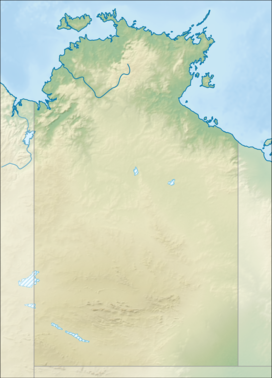| Kata Tjuṯa / Mount Olga | |
|---|---|
 | |
| Highest point | |
| Peak | Mount Olga |
| Elevation | 1,066 m (3,497 ft)[1] |
| Prominence | 487 m (1,598 ft)[2] |
| Coordinates | 25°18′S 130°44′E / 25.300°S 130.733°E |
| Naming | |
| Native name | Kata Tjuṯa (Pitjantjatjara) |
| Geography | |

Kata Tjuṯa (Pitjantjatjara: Kata Tjuṯa, lit. 'many heads'; Aboriginal pronunciation: [kɐtɐ cʊʈɐ]), also known as The Olgas and officially gazetted as Kata Tjuta / Mount Olga,[3] is a group of large, domed rock formations or bornhardts located about 360 km (220 mi) southwest of Alice Springs, in the southern part of the Northern Territory, central Australia. Uluṟu / Ayers Rock, located 25 km (16 mi) to the east, and Kata Tjuṯa / The Olgas form the two major landmarks within the Uluṟu-Kata Tjuṯa National Park. The park is considered sacred to the local Aboriginal community.[4]: 884
The 36 domes that make up Kata Tjuṯa / Mount Olga cover an area of 21.68 km2 (8.37 sq mi) are composed of conglomerate, a sedimentary rock consisting of cobbles and boulders of varying rock types including granite and basalt, cemented by a matrix of coarse sandstone. The highest dome, Mount Olga, is 1,066 m (3,497 ft) above sea level, or approximately 546 m (1,791 ft) above the surrounding plain (198 m (650 ft) higher than Uluṟu).[1] Kata Tjuṯa is located at the eastern end of the Docker River Road.
- ^ a b Uluṟu-Kata Tjuṯa National Park Visitors Guide Archived 2008-08-30 at the Wayback Machine. Retrieved 26 April 2013
- ^ "Kata Tjuta". Peakbagger. Retrieved 15 March 2023.
- ^ "Kata Tjuta / Mount Olga". Northern Territory Place Names Register. Northern Territory Government. 6 November 2002. Archived from the original on 3 February 2023. Retrieved 6 March 2023.
- ^ Engels, Christoph (2010). 1000 Sacred Places. Tandem Verlag GmbH.

